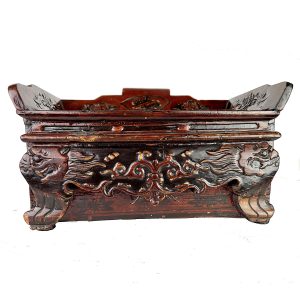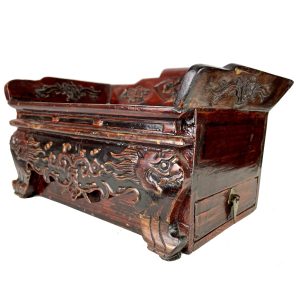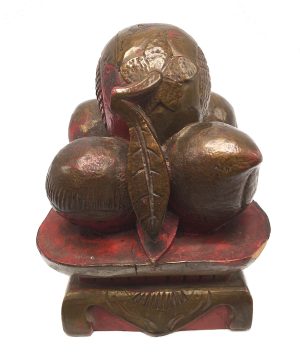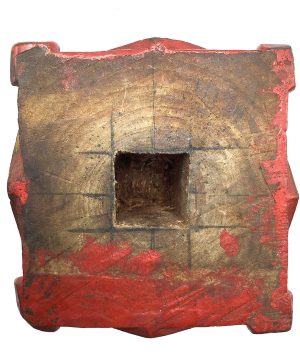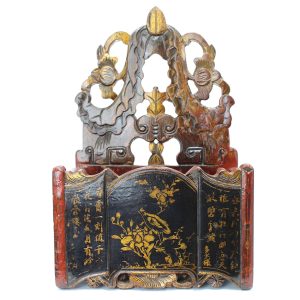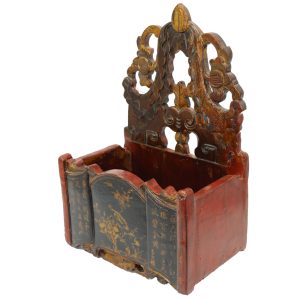Showing 1–12 of 32 results
-
Sale!


$325.00 Original price was: $325.00.$285.00Current price is: $285.00.
H: 6.375″ W: 10.75″ D: 7.125″ | FREE SHIPPING WITHIN CONTINENTAL U.S.!
This charming carved and lacquered multi-use box opens from the top and has a side drawer with a metal pull. It is decorated with auspicious carved symbols for a good, healthy, prosperous and long life Carved fu lion heads with flowing manes adorn the front and plum blossoms and a fan the front and frame. Painted calligraphic phrases refer to a wish for many sons. It was likely a wedding gift to newlyweds and still for that or other purpose.
-
Sale!


$225.00 Original price was: $225.00.$155.00Current price is: $155.00.
H: 4.75 ” Dia: 3.675 ” | FREE SHIPPING WITHIN CONTINENTAL U.S.!
This antique carving of a wood food offering with a lacquer coating was an auspicious ornament for a Chinese bed to bring the lucky couple prosperity, health and a happy life. The pomegranate on top is a fertility and the four peaches below are longevity symbols. The combination of the fruits is a wish for many sons and longevity and is perfect gift for newlyweds.
-


$105.00
H: 4″ W: 9.5″ D: 4.5 ” | FREE SHIPPING!
This charming fanciful vintage underglaze blue and white porcelain pillow has added hand-painted green and red florals, fruits and vases in relief within framed geometric borders of blue cobalt oxide pigment. The top curves in the center to cradle the neck for comfort and flares outward. The front and back sides have charming painted relief images of vases on the front and fruit on the back. The top and bottom have seals applied to Chinese antiques indicating they were approved for export. There is a slight chip on the front, otherwise it is in excellent condition.
-
Sale!


$185.00 Original price was: $185.00.$145.00Current price is: $145.00.
H: 7.125″ W: 8.375″ D: 3.75″ | FREE SHIPPING WITHIN CONTINENTAL U.S.
This Shiwan green chopsticks holder is divided into two parts with holes on top for hanging and small holes on the bottom for drainage. Chopsticks were often wedding gifts from mothers to daughters with many auspicious wishes: phrases for sons as soon as possible, upside down bats with coins and ribbon meaning “blessings in front of your eyes,” and border clouds and thunder symbolizing life-giving rain and abundance.
-
Sale!


$350.00 Original price was: $350.00.$295.00Current price is: $295.00.
H: 10.75″ W: 7″ D: 4.5″ | CALL 213-568-3030 OR EMAIL [email protected] FOR SHIPPING.
The auspicious symbols on this charming document holder which are puns for “harmony and unity in marriage” indicate it was it was probably a wedding gift. And would serve that purpose admirably today as a decorative practical accessory and something you won’t find on a wedding registry.
-
Sale!


$235.00 Original price was: $235.00.$185.00Current price is: $185.00.
H: 7.25″ W: 5″ D: 5″ | FREE SHIPPING WITHIN CONTINENTAL U.S.!
This five-sided Shiwan stoneware pillow with slanted top, open bottom, vibrant glazed surface, and etched coin and diamond design was used for smoking opium as the cool shell cradled the users’ heads and necks and offset the warmth of smoking and the hollow inside stored valuables. We have another which can be paired with it. If a candle is placed inside it emits an amazing shadowy form of a coin, which appealed to those in an opium state.
-
Sale!


$235.00 Original price was: $235.00.$150.00Current price is: $150.00.
H: 10.5” W: 3.25” D: 2.375” | FREE SHIPPING WITHIN CONTINENTAL U.S. !
This elegant antique heddle-pulley carved from a single piece of Burmese teak is topped by a hamsa, a goose-like bird and a sacred Buddhist symbol of wisdom. Auspicious symbolic animal images are believed protect the weaver, assure quality weaving, and pleases the gods and spirits. It is wonderfully weathered from time and use.
-
Sale!


$385.00 Original price was: $385.00.$325.00Current price is: $325.00.
Ht: 8.5” W: 15” D: 9” | CALL 213-568-3030 OR EMAIL [email protected] FOR SHIPPING COST
Given the auspicious images on this finely crafted red and gilt jewelry box, it was probably a wedding gift for a fortunate couple as a wish for fertility, harmony and many and sons. The doors have a carved lotus symbolizing beauty and purity and the top has 5 bats surrounding a longevity roundel. When depicted on a box, it means as “May you have a harmonious marriage with the Five Blessings” (longevity, health, wealth, virtue and a peaceful death) and signifies completeness, togetherness and harmony.
-


$395.00
H: 5.75″ W: 3.25″ D: 2.75″ | FREE SHIPPING WITHIN CONTINENTAL U.S.!
Each of this whimsical gold and red-burgundy lacquered pair of male fu lions sits erect on a high pedestal heads thrown back with flaring ears, bulging eyes, decorative stylized manes and a small bushy tail. Their spirituality is displayed by the pair silently emitting the blessed mantra “aum”: the open mouthed lion forming an “au,” and the other completing it with a closed mouth to form “mmm.” The workmanship on these pieces is masterful, although rustic and provincial, and they are rare with their Buddhist symbolism and because most pairs of fu lions pairs were lost during China’s modernization.
-
Sale!


$595.00 Original price was: $595.00.$425.00Current price is: $425.00.
H: 16.375″ W: 13.625″ D: 5.75″ | FOR SHIPPING INFORMATION CONTACT US AT 213-568-3030 or [email protected]
This intricately carved black and heavily gilt antique cabinet is a fine example of a Straits Chinese furniture made in Guangdong for the Southeast Asia market. Carved openwork panels with phoenixes and lotuses are symbolic wishes for harmony, blessings, rank, good fortune; outstretched wings wish for harmonious marriage, many sons and the inside decoration a wish for status and successful career. Although flamboyant for todays taste, it is a unique accent piece and gift for newly weds.
-
Sale!


$450.00 Original price was: $450.00.$325.00Current price is: $325.00.
H: 22 ” W: 21.5 ” D: .12.25 ” | FREE SHIPPING WITHIN CONTINENTAL U.S.!
This small elm cabinet is from Fujian province known highly decorative vernacular for the new wealthy merchant class. Vernacular furniture was often red lacquer with auspicious symbols. The left door has a magpie on plum tree branch and the right a magpie with a chrysanthemum. The magpie is the bird of joy and happiness and the magpie and chrysanthemum mean “May the whole family be happy,” The a plum symbolizes longevity) and when they have 5 leaves are a wish for the Five Joys/Happinesses: health, wealth, longevity, a life of virtue and a peaceful death. These cabinets were perfect gifts for newlyweds as a desire for double happiness, a long and fruitful marriage with sons
-
Sale!


$695.00 Original price was: $695.00.$495.00Current price is: $495.00.
Ht: 20.75” W: 19.125” D: 11” |CALL 213-568-3030 OR EMAIL [email protected] FOR SHIPPING COST
This very fine ladies vanity cabinet is covered with red lacquer, the color of blessings (fu), highlighted with gold and deeply carved and painted decorations of auspicious symbols to bring happiness, good fortune, long life and many sons to the elite couple who may have received it as a wedding gift by parents in hopes of them successfully carrying on the family tradition. This is a reflection of the Confucian belief having sons to carry on the family name is essential to real happiness.
End of content
End of content

